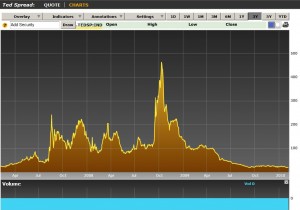Many of us have heard about the TED Spread, especially since 2008 when it became a closely followed topic during the credit crisis. While it has fallen below the radar recently, it can always be used to provide a measure of stress (or not) in the credit markets. One current but somewhat localized measure of increasing stress is the basis point spread in the ten year bond yields between Greece and Germany. Concerns about Greek government default have moved that spread from 225 basis points ten months ago to more than 350 basis points recently. The TED Spread, because it reflects stress (or not) in credit flows in THE reserve currency and in the world’s largest economy, it is an indicator of world financial and economic health. I put it in those terms because as we have seen large moves in the TED spread impact other financial markets and can be an indicator of economic health.
The Ted Spread is the interest rate differential between the 3 month London Interbank Offered rate (LIBOR) in US dollars and the 3 month US T-Bill rate. Of course there are other terms such as, a 6 month LIBOR and a 6 month T-Bill. So one could talk about a 6 month TED spread. But typically, when talking TED spreads, one is talking the 3 month spread. TED stands for Treasury Bill and Euro-dollar or LIBOR in US dollars.
An investment in US T-Bills is considered risk free. While an investment in a large bank may not normally appear to carry a great deal of risk, there is always a yield greater than a US T-Bill investment. Typically, the TED spread is between 10 and 50 basis points. An increasing spread, particularly over the “norm” is an indication of an increasing reluctance on the part of banks to lend to one another due to greater perceived credit risk.
Note in the graph how volatile the TED spread has been over the last 3 years. During the financial crisis in 2008, in the aftermath of the Lehman bankruptcy, it hit a record spread of 465 basis points. That magnitude of spread indicated a virtual shut down in interbank lending. And if the large world banks are reluctant to lend to one another, how reluctant will they be in placing new commercial loans?
Fortunately, the Fed did what was necessary to eventually bring us back to some normalcy. We can see that in the TED spread which is currently about 15BPs. Use the TED spread as an indication of easing or tightening credit markets. It was useful to investors during the crisis of 2008.








